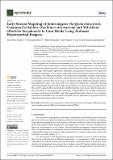Por favor, use este identificador para citar o enlazar a este item:
http://hdl.handle.net/10261/330912COMPARTIR / EXPORTAR:
 SHARE SHARE
 CORE
BASE CORE
BASE
|
|
| Visualizar otros formatos: MARC | Dublin Core | RDF | ORE | MODS | METS | DIDL | DATACITE | |

| Título: | Early-Season Mapping of Johnsongrass (Sorghum halepense), Common Cocklebur (Xanthium strumarium) and Velvetleaf (Abutilon theophrasti) in Corn Fields Using Airborne Hyperspectral Imagery |
Autor: | Martín, M. Pilar ; Ponce, Bernarda; Echavarría, Pilar; Dorado, José CSIC ORCID ; Fernández-Quintanilla, César CSIC ORCID | Palabras clave: | Site-specific weed management Maize Airborne hyperspectral images Field spectroscopy Spectral angle mapper (SAM) Spectral mixture analysis (SMA) |
Fecha de publicación: | 2023 | Editor: | Multidisciplinary Digital Publishing Institute | Citación: | Agronomy 13(2): 528 (2023) | Resumen: | Accurate information on the spatial distribution of weeds is the key to effective site-specific weed management and the efficient and sustainable use of weed control measures. This work focuses on the early detection of johnsongrass, common cocklebur and velvetleaf present in a corn field using high resolution airborne hyperspectral imagery acquired when corn plants were in a four to six leaf growth stage. Following the appropriate radiometric and geometric corrections, two supervised classification techniques, such as spectral angle mapper (SAM) and spectral mixture analysis (SMA) were applied. Two different procedures were compared for endmember selections: field spectral measurements and automatic methods to identify pure pixels in the image. Maps for both, overall weeds and for each of the three weed species, were obtained with the different classification methods and endmember sources. The best results were achieved by defining the endmembers through spectral information collected with a field spectroradiometer. Overall accuracies ranged between 60% and 80% using SAM for maps that do not differentiate the weed species while it decreased to 52% when the three weed species were individually classified. In this case, the SMA classification technique clearly improved the SAM results. The proposed methodology shows it to be a promising prospect to be applicable to low cost images acquired by the new generation of hyperspectral sensors onboard unmanned aerial vehicles (UAVs). | Descripción: | Este artículo está sujeto a una licencia CC BY 4.0 | Versión del editor: | https://doi.org/10.3390/agronomy13020528 | URI: | http://hdl.handle.net/10261/330912 | DOI: | 10.3390/agronomy13020528 | E-ISSN: | 2073-4395 |
| Aparece en las colecciones: | (CCHS-IEGD) Artículos (ICA) Artículos |
Ficheros en este ítem:
| Fichero | Descripción | Tamaño | Formato | |
|---|---|---|---|---|
| agronomy-13-00528-v2.pdf | 2,92 MB | Adobe PDF |  Visualizar/Abrir |
CORE Recommender
SCOPUSTM
Citations
6
checked on 16-may-2024
WEB OF SCIENCETM
Citations
3
checked on 20-feb-2024
Page view(s)
36
checked on 26-may-2024
Download(s)
26
checked on 26-may-2024
Google ScholarTM
Check
Altmetric
Altmetric
Este item está licenciado bajo una Licencia Creative Commons

